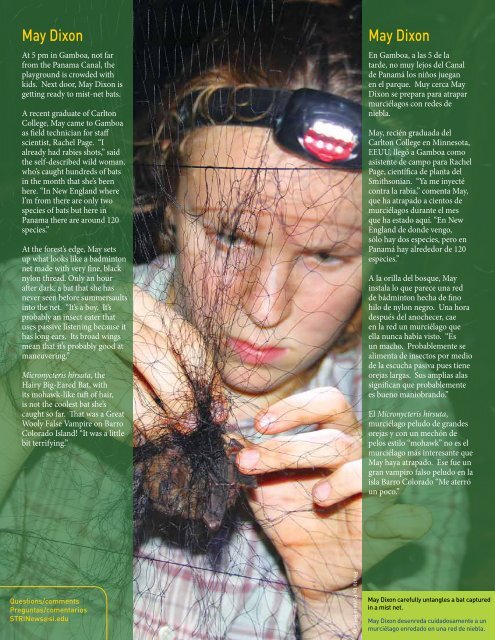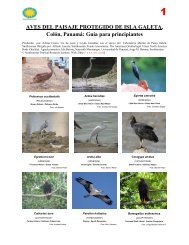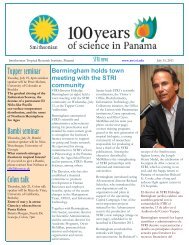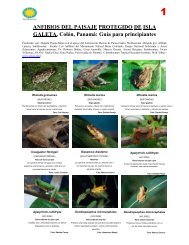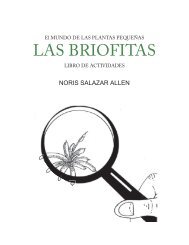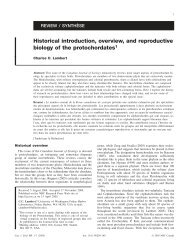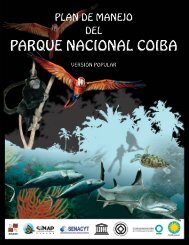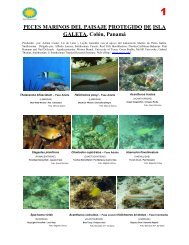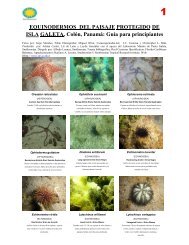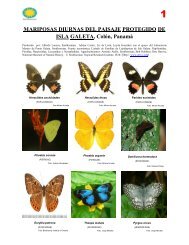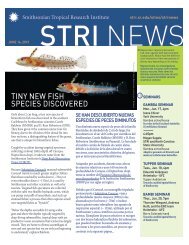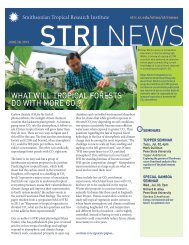Why do different butterfly species have similar wing patterns?
Why do different butterfly species have similar wing patterns?
Why do different butterfly species have similar wing patterns?
Create successful ePaper yourself
Turn your PDF publications into a flip-book with our unique Google optimized e-Paper software.
May Dixon<br />
At 5 pm in Gamboa, not far<br />
from the Panama Canal, the<br />
playground is crowded with<br />
kids. Next <strong>do</strong>or, May Dixon is<br />
getting ready to mist-net bats.<br />
A recent graduate of Carlton<br />
College, May came to Gamboa<br />
as field technician for staff<br />
scientist, Rachel Page. “I<br />
already had rabies shots,” said<br />
the self-described wild woman,<br />
who’s caught hundreds of bats<br />
in the month that she’s been<br />
here. “In New England where<br />
I’m from there are only two<br />
<strong>species</strong> of bats but here in<br />
Panama there are around 120<br />
<strong>species</strong>.”<br />
At the forest’s edge, May sets<br />
up what looks like a badminton<br />
net made with very fine, black<br />
nylon thread. Only an hour<br />
after dark, a bat that she has<br />
never seen before summersaults<br />
into the net. “It’s a boy. It’s<br />
probably an insect eater that<br />
uses passive listening because it<br />
has long ears. Its broad <strong>wing</strong>s<br />
mean that it’s probably good at<br />
maneuvering.”<br />
Micronycteris hirsuta, the<br />
Hairy Big-Eared Bat, with<br />
its mohawk-like tuft of hair,<br />
is not the coolest bat she’s<br />
caught so far. That was a Great<br />
Wooly False Vampire on Barro<br />
Colora<strong>do</strong> Island! “It was a little<br />
bit terrifying.”<br />
May Dixon<br />
En Gamboa, a las 5 de la<br />
tarde, no muy lejos del Canal<br />
de Panamá los niños juegan<br />
en el parque. Muy cerca May<br />
Dixon se prepara para atrapar<br />
murciélagos con redes de<br />
niebla.<br />
May, recién graduada del<br />
Carlton College en Minnesota,<br />
EEUU, llegó a Gamboa como<br />
asistente de campo para Rachel<br />
Page, científica de planta del<br />
Smithsonian. “Ya me inyecté<br />
contra la rabia,” comenta May,<br />
que ha atrapa<strong>do</strong> a cientos de<br />
murciélagos durante el mes<br />
que ha esta<strong>do</strong> aquí. “En New<br />
England de <strong>do</strong>nde vengo,<br />
sólo hay <strong>do</strong>s e<strong>species</strong>, pero en<br />
Panamá hay alrede<strong>do</strong>r de 120<br />
e<strong>species</strong>.”<br />
A la orilla del bosque, May<br />
instala lo que parece una red<br />
de bádminton hecha de fino<br />
hilo de nylon negro. Una hora<br />
después del anochecer, cae<br />
en la red un murciélago que<br />
ella nunca había visto. “Es<br />
un macho. Probablemente se<br />
alimenta de insectos por medio<br />
de la escucha pasiva pues tiene<br />
orejas largas. Sus amplias alas<br />
significan que probablemente<br />
es bueno maniobran<strong>do</strong>.”<br />
El Micronycteris hirsuta,<br />
murciélago pelu<strong>do</strong> de grandes<br />
orejas y con un mechón de<br />
pelos estilo “mohawk” no es el<br />
murciélago más interesante que<br />
May haya atrapa<strong>do</strong>. Ese fue un<br />
gran vampiro falso pelu<strong>do</strong> en la<br />
isla Barro Colora<strong>do</strong> “Me aterró<br />
un poco.”<br />
Questions/comments<br />
Preguntas/comentarios<br />
STRINews@si.edu<br />
Photo by Pamela Belding<br />
May Dixon carefully untangles a bat captured<br />
in a mist net.<br />
May Dixon desenreda cuida<strong>do</strong>samente a un<br />
murciélago enreda<strong>do</strong> en una red de niebla.


